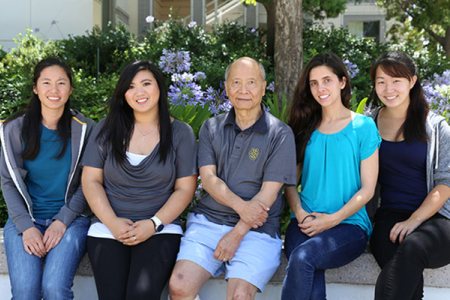Artificial Retina Team Wins Research Competition
 July 6, 2016 - A team of biomedical engineering, chemical engineering and materials science engineering graduate students is one step closer to turning its artificial retina research into reality after sweeping both categories of a national research competition last week. Samueli School students Rachel Rosenzweig, Elena Liang, Mary Nora Dickson and Emma Mah beat out 22 other teams to win the first-place prize of $3,000 in the MIT Convergence Idea Challenge for their artificial bio-nanoelectronic retina idea; they also won the Community Choice award of $1,000.
July 6, 2016 - A team of biomedical engineering, chemical engineering and materials science engineering graduate students is one step closer to turning its artificial retina research into reality after sweeping both categories of a national research competition last week. Samueli School students Rachel Rosenzweig, Elena Liang, Mary Nora Dickson and Emma Mah beat out 22 other teams to win the first-place prize of $3,000 in the MIT Convergence Idea Challenge for their artificial bio-nanoelectronic retina idea; they also won the Community Choice award of $1,000.
The Convergence Idea Challenge was launched to encourage emerging researchers to combine the disciplines of life sciences, physical sciences, information technology, social sciences and engineering to improve human health. The competition was sponsored and judged by a panel of eminent academics: Nobel Laureate Phil Sharp, MIT President Emerita Susan Hockfield and Koch Institute for Integrative Cancer Research Director Tyler Jacks. Research was judged on its potential impact, creativity and presentation.
Retinal degeneration, including retinitis pigmentosa, age-related macular degeneration and diabetic retinopathy affect nearly 15 million Americans alone, the first-place UCI team says. The only available therapy is an artificial retina, but so far, none has been completely successful in restoring vision.
The team is combining biology, nanotechnology and electronics to design an artificial retina as a flexible organic photovoltaic cell. They are using inexpensive biocompatible, photo-sensitive, polymer-based material, which converts light into pulsed electric signals, stimulating nearby neurons for visual processing through optical excitation. Because the nanomaterial is coupled with living neuronal tissues, the retina is expected to adhere to the patient’s own cells more effectively than current artificial models, reducing rejection and increasing the chances that surrounding cells will stay viable.
In addition to beating out teams from Harvard, MIT, Stanford, Johns Hopkins, Stanford, University of Illinois at Urbana Champaign and University of Cambridge, among others, the group also received the most “likes” on the contest Facebook page, earning it the Community Challenge Award.
The winning research also was mentioned at the National Academy of Sciences in Washington D.C., alongside the release of a convergence policy report, "Convergence: The Future of Health," as aligning with the policy’s goals.
In their contest application, the graduate students explained: “Our proposed idea will provide a cost-efficient, mechanically robust, long-term solution to patients suffering from retinal degeneration. … The grand vision of our multidisciplinary approach is to engineer an affordable, long-lasting, biocompatible, self-contained, high-resolution and electrically efficient bio-nanoelectronic device as an artificial retina to restore native vision in patients around the world.”
“Winning this contest has made us extremely proud to be such collaborative, multidisciplinary Anteaters in the AFYee Research Group,” says Rosenzweig, referring to the team’s adviser, Albert Yee, chemical engineering and materials science professor. “It has bolstered our commitment to interdisciplinarity for executing creative, cutting-edge solutions to healthcare problems.”
Yee is delighted with the group’s accomplishment. “I am really impressed with the enthusiasm and ingenuity displayed by the team. We had this loose idea of an artificial retina a couple of years ago but the team has fleshed in the critical details that we must now focus on. I am extremely proud of them,” he says.
Rosenzweig said they plan to use the $4,000 prize to fund materials and equipment to further their research and development, adding that a prototype is in the design phase. “Afterwards, we plan to share our research finding with the broader community through conferences and symposia,” she says.
“We hope our contribution will inspire elected officials, government agencies and the community to further promote convergence research.”
-- Anna Lynn Spitzer
